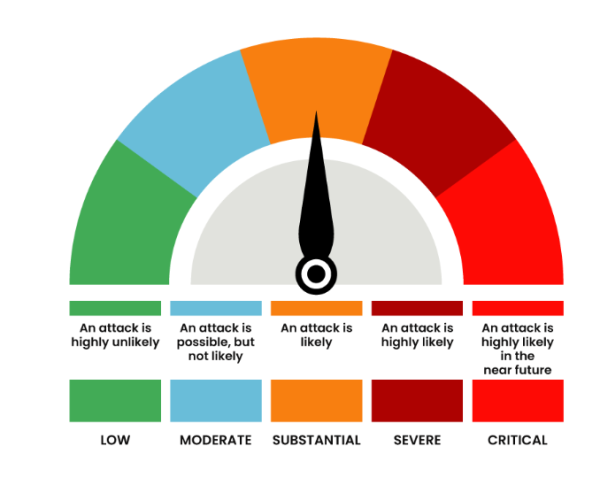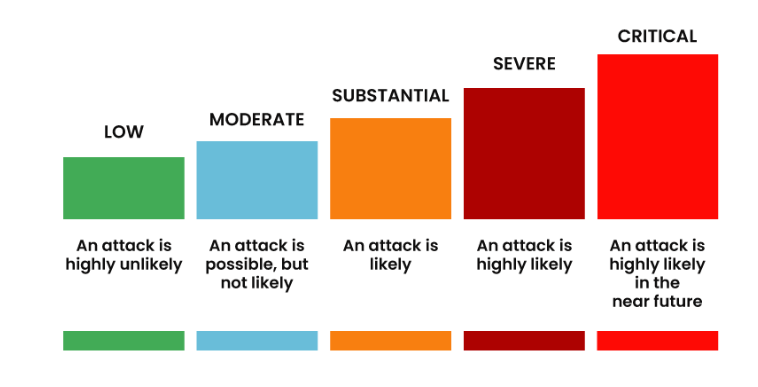Threat levels are a system used by government and security agencies to communicate the current level of risk or likelihood of a terrorist attack or other security threats. These threat levels are often color-coded or use descriptive terms to convey the degree of threat, and they serve several key purposes:
Public Awareness: Threat levels are primarily intended to inform the general public, businesses, and organizations about the current level of risk they face from potential terrorist activities or other security threats.
Security Preparedness: They help security practitioners, including law enforcement, government agencies, and critical infrastructure operators, assess the level of security measures that may be necessary to protect against potential threats.
Resource Allocation: The threat levels assist authorities in allocating resources effectively. When the threat level is elevated, additional security measures may be put in place, such as increased police presence at public events or heightened airport security.
Risk Assessment: Businesses and organizations can use threat levels to evaluate their own risk and make informed decisions about their security protocols and preparedness.
Public Confidence: By openly sharing threat levels with the public, authorities aim to maintain public confidence and trust in the government’s efforts to address security threats.

Image source: Protect UK [1]
Determining threat levels involves a multi-faceted assessment process:
The national threat level for the UK pertaining to all forms of terrorism, encompassing various ideologies such as Islamist, extreme right-wing, LASIT, and Northern Ireland-related threats, is established by the Joint Terrorism Analysis Centre (JTAC).
For Northern Ireland specifically, the threat level is independently determined by the Security Services.
When evaluating the appropriate threat level for a given situation, several key factors are considered:
Available Intelligence: Specific, credible threat information is infrequent. Typically, threat assessments rely on a diverse range of information, often incomplete or fragmented. This includes analysis of current terrorist activities, international comparisons, and past attacks. Intelligence provides only a partial view of the overall situation.
Terrorist Capability: An examination of the known capabilities of the involved terrorists and their potential methods, drawing insights from past attacks and gathered intelligence. This assessment also considers the potential scale of an attack.
Terrorist Intentions: Intelligence and publicly available data are used to understand the overarching goals of the terrorist groups, their strategies, and the types of targets they might contemplate attacking.
Timescale: The threat level conveys the likelihood of an attack happening in the near future. While some attacks are meticulously planned over years, others are expedited. In the absence of precise intelligence, experts must make a judgment regarding how close an attack might be to occurring. Threat levels are subject to periodic review to ensure their current relevance.
Threat levels are intended to provide a general assessment of the probability of a terrorist attack:

Threat levels, by themselves, do not necessitate specific actions from the public. They serve as tools for security professionals in various sectors, including Critical and law enforcement, to assess the need for protective security measures.
However, remaining vigilant is crucial, irrespective of the current national threat level. This is especially true given the prevailing national threat conditions. Sharing national threat levels with the general public is essential as it provides important context for understanding security measures encountered in daily life, such as those at airports or during bag searches.
If you possess information regarding potential terrorist activity, please contact the Anti-Terrorist Hotline at 0800 789 321. The Anti-Terrorist Hotline is designated for reporting tips and confidential information. In the event of immediate threats like possible explosives, please dial 999.
MI5 [2]
National threat level | |
| Date | Threat Level |
| 9 February 2022 | SUBSTANTIAL |
| 15 November 2021 | SEVERE |
| 4 February 2021 | SUBSTANTIAL |
| 3 November 2020 | SEVERE |
| 4 November 2019 | SUBSTANTIAL |
| 23 July 2019 | SEVERE |
Date | Threat from international terrorism | Threat from Northern Ireland-related terrorism | |
|---|---|---|---|
in Northern Ireland | in Great Britain | ||
1 March 2018 | SEVERE | SEVERE | MODERATE |
17 September 2017 | SEVERE | SEVERE | SUBSTANTIAL |
15 September 2017 | CRITICAL | SEVERE | SUBSTANTIAL |
27 May 2017 | SEVERE | SEVERE | SUBSTANTIAL |
23 May 2017 | CRITICAL | SEVERE | SUBSTANTIAL |
11 May 2016 | SEVERE | SEVERE | SUBSTANTIAL |
29 August 2014 | SEVERE | SEVERE | MODERATE |
24 October 2012 | SUBSTANTIAL | SEVERE | MODERATE |
11 July 2011 | SUBSTANTIAL | SEVERE | SUBSTANTIAL |
24 September 2010 | SEVERE | SEVERE (first published) | SUBSTANTIAL (first published) |
22 January 2010 | SEVERE | ||
20 July 2009 | SUBSTANTIAL | ||
4 July 2007 | SEVERE | ||
30 June 2007 | CRITICAL | ||
13 August 2006 | SEVERE | ||
10 August 2006 | CRITICAL | ||
1 August 2006 | SEVERE (first published) | ||
MI5 [2]
Protect UK Police. Threat Levels. [Online]. Available at: https://www.protectuk.police.uk/threat-levels. Accessed September 11, 2023. [1]
MI5. Threat Levels. [Online]. Available at: https://www.mi5.gov.uk/threat-levels. Accessed September 11, 2023. [2]